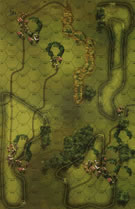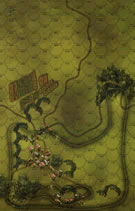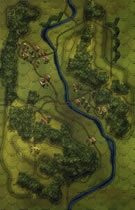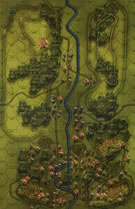|
Through the Ardennes Fall of France 1 #5 |
||
|---|---|---|
| (Attacker) Germany | vs | France (Defender) |
| Formations Involved | ||
|---|---|---|
| France |  |
1re Division Légères de Cavalerie |
| Germany |  |
32nd Infantry Division |
| Germany |  |
7th Panzer Division |

| Total | |
|---|---|
| Side 1 | 11 |
| Draw | 6 |
| Side 2 | 2 |
| Overall Rating, 19 votes |
|---|
|
3.84
|
| Scenario Rank: 154 of 913 |
| Parent Game | Fall of France 1 |
|---|---|
| Historicity | Historical |
| Date | 1940-05-11 |
| Start Time | 12:00 |
| Turn Count | 20 |
| Visibility | Day |
| Counters | 128 |
| Net Morale | 0 |
| Net Initiative | 2 |
| Maps | 4: 26, 27, 29, 30 |
| Layout Dimensions | 86 x 56 cm 34 x 22 in |
| Play Bounty | 125 |
| AAR Bounty | 129 |
| Total Plays | 19 |
| Total AARs | 8 |
| Battle Types |
|---|
| Delaying Action |
| River Crossing |
| Conditions |
|---|
| Off-board Artillery |
| Scenario Requirements & Playability | |
|---|---|
| Fall of France 1 | Base Game |
| Introduction |
|---|
|
At the outbreak of the war, the Divisions Légères de Cavalerie were ordered into the Ardennes to delay any German advance there until Ninth Army's infantry divisions could establish a strong defense along the Meuse river. But the cavalrymen badly misjudged German movements, expecting that it would take at least five days for the Germans to make their way through the forest. the rapid advance of the German motorized divisions caught the French forces off guard, and when they reached the Lomme River the French were not in a position to stop them. |
| Conclusion |
|---|
|
At noon the motorcycle platoons and armored cars of the 1st Régiment d'Automitrailleuses clashed with the advance elements of Group Fürst, 7th Panzer Division near the Chavannes crossroad. Several armored cars were damaged on both sides before the French fell back towards Lomme. German attacks all along the river line were putting French formations in distress, and when word came that the 4th Division Légères de Cavalerie had retreated the French send in some anti-tank gun platoons to defend the river bridges while the engineers worked to blow them up. The maneuver worked, and the bridges were blown successfully after all French units had retreated behind the river. |
| AFV Rules Pertaining to this Scenario's Order of Battle |
|---|
|
| 3 Errata Items | |
|---|---|
| Scen 5 |
The Scenario Special Rules (SSRs) fail to identify the German SK221 & SK222 armored cars as open-topped AFV's. (treadasaurusrex
on 2021 Nov 22)
|

|
The reduced direct fire value of the Heer HMG became 5-5 starting with Fall of France. (plloyd1010
on 2015 Jul 31)
|

|
The morale and combat modifiers of German Sergeant #1614 should be "0", not "8". (Shad
on 2010 Dec 15)
|
| Fall of France escenario 5 |
|---|
|
En este escenario, una considerable fuerza alemana, integrada por dos batallones de infantería, dos compañías de motociclistas, un escuadrón de caballería, una compañía de tanques PzI y otra de tanques PzII, junto con dos compañías de coches blindados de reconocimiento y con el apoyo de ingenieros, artillería y cañones AT, se enfrenta a unidades de la 1ª División Légère de Cavalerie francesa. Los franceses cuentan con tres compañías de motociclistas, dos compañías de ametralladoras, un escuadrón de caballería y el apoyo de dos compañías de diversos coches blindados, morteros, cuatro de baterías AT de 25mm y dos pelotones de ingenieros, cuyo papel es esencial en esta batalla. Los franceses tienen como misión impedir al enemigo el paso del río Lomme, cruzado por ocho puentes. Les estrategia de los franceses es desplegar varias unidades al este del río para retardar el avance alemán, mientras que los ingenieros galos destruyen el mayor número posible de puentes. Los alemanes entran por el borde este del campo de batalla. Su plan consiste en avanzar con las unidades rápidas lo antes posible hasta los puentes, ocuparlos antes de que sean destruidos, establecer cabezas de puente y defenderlas hasta la llegada del grueso de sus fuerzas. Los franceses despliegan sus unidades avanzadas en las carreteras y nudos de comunicaciones para impedir el paso de las unidades rápidas enemigas. Han constituido una reserva con los coches blindados y una compañía de dragones motociclistas en el centro del campo de batalla. El resto de las unidades protegen los puentes y sus accesos. Los alemanes entran en el campo de batalla y avanzan con sus motociclistas, tanques y caballería hacia el río. Hacen caso omiso de los puntos de resistencia franceses en las carreteras, que rodean sin combatir. Dejan la tarea de desalojarlos a la infantería, que avanza detrás. Ante esta táctica, los franceses se retiran hacia el río, aunque las unidades más lentas -secciones de HMG- quedan atrás. Mientras tanto, los ingenieros franceses comienzan a destruir lentamente los puentes. La intensidad de la batalla se desplaza hacia las orillas del río Lomme, donde se entablan duros combates. La caballería alemana sortea las posiciones de bloqueo francesas y llega hasta el río en el sector sur, donde entabla combates con secciones de dragones motociclistas. La mayoría de los coches blindados germanos llega hasta las inmediaciones del río en el sector norte, siendo detenidos por la fuerte resistencia francesa. El grueso de los motociclistas alemanes junto con tanques PZI y PzII avanzan en el sector central, donde son blanco de las batería francesas AT de 25mm, que destruyen varios vehículos. Los combates se desnivelan en favor de los alemanes cuando su infantería consigue llegar a las inmediaciones del río. Entonces los franceses intensifican el trabajo de sus ingenieros, que consiguen destruir seis de los ocho puentes. En ese moento se producen épicos combates por los dos puentes restantes, que al final los alemanes consiguen controlar, pero no logran cruzar el río ante la durísima resistencia francesa. Pero una sección de ingenieros alemanes consigue hacer cruzar el río a unidades aisladas de infantería en el sector central, infiltración que los franceses no consiguen cauterizar. Tras arduas luchas la resistencia francesa se desmorona en el sector norte en el penúltimo turno y el grueso de las fuerzas alemanas en esa zona consigue cruzar el río. Al final los alemanes consiguen una estrechísima victoria por la mínima. Los franceses han estado a un "step" de conseguir el empate. Magnífico escenario. Enseñanzas: los franceses deberían desplegar sus fuerzas a orillas del río, "blindando" los accesos inmediatos a los puentes y dando prioridad a los ingenieros para su rápida destrucción. |
| 0 Comments |
| faire sauter les ponts (Blow the bridges) | ||||||||||||
|---|---|---|---|---|---|---|---|---|---|---|---|---|
Great battle using four maps and a number of different unit types (AFV's through Calvary). This battle allows for movement and combined arms assaults. Of course the French have fewer troops and are on defense, but the river and goal of capturing the bridges helps focus the battle into certain areas of the map. The French are much better off if they can blow some of the bridges. I had the French work on blowing the northern bridges while defending the town to buy time for the ENG to move south along the river blowing the bridges. Some french units were posted on the hills to slow and disrupt the German advance. The battle stared well for the French. They disrupted some of the German attack and were able to blow the two northern most bridges on their first try (after meeting the scenario requirements). The ENG's headed south to the next set of bridges. At this point they seemed to have forgotten how to use their explosives and were soon balancing blowing the bridges and defending themselves. Elsewhere on the battlefield the Germans began wearing down the French, with the isolated units suffering the most. The Germans lost a some forces, most notably several steps of AFV's. In the town and forests the French focus on holding assault hexes by recovering on their action phases and defending against the German assaults. The Germans needs both leaders and AFV's to improve their assaults and push back the French. In the end the Germans capture a couple bridges that the French ENGs could not get to, but the other French troops are able to destroy enough German steps to gain their own major victory conditions leading to a draw. Using the French portee units placed in towns across the river were able to use their range and firepower to teach the German AVF's to be more careful on their approach as they watched their friends go up in smoke. With the size and scale of this battle the alternating actions phases have an effect on the outcome, with a side often having to decide which action to take by weighing the benefits and risks posed to other units, the wrong call may lead to a failed action and negative effect on the at risk unit. |
||||||||||||
| 0 Comments |
| Stalling the Blitz | ||||||||||||
|---|---|---|---|---|---|---|---|---|---|---|---|---|
May 11, 1940 found the Germans advancing rapidly east through the Ardennes region and surprising elements of the French 1st Division Légères de Cavalerie along the Lomme River. Units from the 7th Panzer Division and 32nd Infantry engaged the unsuspecting French cavalry around noon as the Germans continued their westward march. The French plan called for blowing all the bridges across the Lomme with single north and south engineer platoons responsible for the bridges in their sector. The first bridge in the south was destroyed by 1230, but progress was slower in the north, where the first bridge wasn’t blown until 1330. The German combined arms force on both the north and south flanks of the French position struck quickly, but the doughty French delayed them with their armored cars and 25mm portees. By 1400 hours, the Germans were in striking distance of one of the north bridges, which was being defended by motorcycle units and cavalry that moved quickly to fill the breech. By 1430, all the bridges in the south town were destroyed, and the engineers there headed north along with any available French units on either side of the river. Fighting was intense by the last remaining north bridge, but French cavalry moved quickly and held the easy bridgehead. The Germans moved both engineers to prepare crossings about 1 Km to the south, and French units scrambled to try and interrupt the crossings there. At 1515, the last French 25mm portee was eliminated, giving field superiority to German armor, and all German units were converging on the two crossing points. However, by 1545 both engineer units had been disrupted and crossings were suspended of and on for the remainder of the skirmish. By 1615, a Pz.I group had eliminated the last French engineer platoon before they could destroy the only remaining bridge, but the French troops held the bridge, albeit barely, until the Germans stood down for the day. This 20-turn scenario is an excellent combined arms exercise as it provides both sides with a diverse mix of armor, artillery and foot units, with the latter including both cavalry and engineers. As in other early Fall of France scenarios, the French are tasked with stopping the German westward flow by interdiction and/or bridge destruction. The sheer number of German forces and the quality of their firepower makes this a tall order for the French, e.g German OBA is 48 compared to 16 for the French. One tough decision at setup for the French is whether to provide trucks for the French HMG’s because of their limited mobility or to the engineers, so they could move quickly from bridge to bridge. If the French can blow all the bridges early and force the Germans to use their engineers to cross the Lomme, the outcome looks much brighter for them. French armored cars and cavalry were used to move quickly to “hot spots” in the early game, and the 25mm portees started out with some high-value Panzer strikes. But the German forces have enough power and mobility also to wear down the French defenses and, if the bridges aren’t destroyed early enough, the Germans may come pouring across. The Germans also enjoyed a major initiative advantage as the French did not have the first move until the 10th turn., while the Germans often had 2-3 actions before the French could respond. That trend reversed as the French had the initiative on 6/10 remaining turns. In the end, this turned out to be a Major French Victory, a result that I never would have expected. While the dispersal of French units on both banks of the Lomme worked out pretty well in the end, their success was also aided by some remarkable die rolls for a single mortar unit and the relatively weak French OBA. In contrast the German OBA kept getting weak hits despite rolling on the “42” column much of the time. The scenario is a lot of fun, as the balance is surprising, and the tension is always there with the Germans pressing to gain the bridges while the French try to slow them by whatever means possible. French units blocked roads forcing turn-consuming assaults or longer journeys for the Germans. The final count was 24 steps lost for each side with the Germans only managing 14 steps west of the Lomme; if the Germans had one more step west of the river, the French victory would have slipped to Minor. |
||||||||||||
| 0 Comments |
| Frantic French Blowing Bridges | ||||||||||||
|---|---|---|---|---|---|---|---|---|---|---|---|---|
Frantic French Blowing Bridges Note: Score will be denoted by (x-y), where x=German casualties, y=French casualties. THE BATTLE1200 German forces enter from the east. One German truck is hit and destroyed by a French Anti-Tank battery. The transported infantry platoon is lost (2-0) French anti-tank fire reduces some SK222s (4-0) before the French in turn are eliminated by German artillery. (4-2) French engineers blow up the northernmost bridge! The Race is On! 1215 Early Fog of War sets in after the Germans initiate a couple assaults. 1230 French Armoured Car in the woods eliminated by assaulting German infantry (4-6). The French AT Guns continue to wreck havoc on the light German tanks and armoured cars. Some Pz Is and SK222s falling victim to the French 25mm. (8-6) German motorcycles and cavalry race toward the river. French blow a bridge up in the south. 1245-1300 German artillery eliminates another AT Gun but not until after another truck unit loaded with infantry is destroyed (10-7) Germans continue to push their motorcycles and cavalry who get behind the French lines in the north. 1315 French Armoured car is hit by German anti-tank guns which advanced and unlimbered last turn. (10-9) Motorcycles race into the French engineers in the northwest. One platoon is lost as they quickly advance past the French (12-9) French engineers blow up a second bridge in the south. German infantry near the first blow bridge in the south. Gameplay Note: The Germans were so intent on obtaining their victory objective (capture of an intact bridge) that they paid little attention to casualties. Unfortunately, causing casualties is one of the alternate French objectives. So nearing 15 German steps eliminated, the French are already close to their Minor Victory objective! 1330 A northern bridge is captured and the French engineers eliminated. (12-10) Further French foot troops are eliminated (12-12). German armoured cars break past the French to get to the bridges in the south. French motorcycles purse them, who are in turn pursued by German infantry. Gameplay Note: This was a big German blunder. Having captured a northern bridge, the Germans should not have pushed to capture a bridge in the south as well. This advance left the armoured cars too exposed to French assault. 1345 German anti-tank fire eliminates French armoured cars (12-14). Further armoured cars are eliminated in assault (12-18). French cavalry is reduced at the bridge and is eliminated fleeing (12-20) German infantry is eliminated approaching French DRG (14-20) 1400 German infantry takes reductions at the bridge (assault) and in the centre (artillery) (16-20). French minor objective obtained. 1415 French cutting back to the north bridge. In the south another bridge is blown. French DRG are taken out in the south (16-22) 1430 French suffer further casualties (16-26) but succeed in overrunning some German infantry and reducing some armoured cars in the heated south battle (19-26) French mortar eliminated (19-27) 1445 French armoured car is hit (19-29) 1500 French are desperate to inflict one more step loss. They initiate assault in the north town. Both sides take a reduction (20-30). Both sides currently have obtained their Major Victory Conditions. It is extremely unlikely the French could repel the Germans from the west side of the river or cause an excess of casualties. The battle is mutually declared over. IT’S A DRAW! AftermathThis was a good fun battle. In hindsight, the Germans were a bit too gung-ho to get to the bridges and suffered too many casualties. They should have concentrated their forces a bit more and held back from the south river town once the northern bridge was captured. A very entertaining and fun battle. Scenario Rating: 4/5. Recommended. |
||||||||||||
| 0 Comments |
| Race for the bridges |
|---|
|
Played this one solo in three sessions (wish I had a whole day, but no..) Beautiful middle sized scenario where the Germans make a run for the intact bridges over the Lomme. The French can blow them with their 2 Engineer units. The blowing was no success, by 15.00 only 3 of them were destroyed. The german attack was 2-pronged, one group for the northern bridges and one for the south. A small detachment with the Engineer unit went to center to force a crossing there. The french held out in the north, but to the south they had to let go of 2 bridges by 2.30. By 3.30 the germans managed to cross the needed amount of steps for a major victory. However, the battle was hard-fought. The germans lost more than 20 steps in total enough for a french major victory. Net result: draw. Noteworthies: The 4 25mm en portee managed very well. Although 2 were lost they destroyed 5 german APC steps. The river crossing was a success, although the detachment was too small to do any further harm. |
| 0 Comments |
| Fall of France Scenario 5 | ||||||||||||
|---|---|---|---|---|---|---|---|---|---|---|---|---|
This was the first scenario I played that I really really liked. It was a larger scale combined arms battle that allowed me to get to grips with some of the more difficult rules. The French deployed close to the river and allowed the Germans to come to them. The French took horrendous losses but did inflict some damage. I played this solo and I believe that my plans as the Germans and deployment was so good that I didnt stand a chance as the French. The game ended up being close though. 3 quarters of the way through the French had blown all the bridges except 2. The 2 the germans held. So the remaining French forces had to counterattack these 2 bridges. The German Major Victory was only cemented on the final turn when I got the last steps over the river. Great scenario |
||||||||||||
| 0 Comments |
| Can't defend everything | ||||||||||||||
|---|---|---|---|---|---|---|---|---|---|---|---|---|---|---|
My one and only play with the French and I think I failed to consider carefully how to take advantage of French units. As it was, I tried to do too much with some units "up front," others blocking roads; and others set for a mobile defense. The old adage applies: try to defend everything, defend nothing. In particular, I did not give much thought to use of cavalry. The French did have a good start, with the Germans racing MC units headlong towards the city bridges. A strong OF roll killed 2X steps on the first combat roll. After that, however, German weight of metal made itself felt and French engineers had a difficult time blowing bridges. Perhaps the key here is to keep the French forces concentrated in one or two main groups rather than rely up small, multiple blocking groups. German concentration is just too much for an effective delaying action. |
||||||||||||||
| 0 Comments |
| Through the Ardennes to Grandmother's House We Don't Go | ||||||||||||||
|---|---|---|---|---|---|---|---|---|---|---|---|---|---|---|
This is a tactically interesting scenario where the Germans have to race, with a predominately motorized force, across the board to capture a bridgehead across the major river. They face a mix of French Cavalry and Dragoon backed by Portees and AMR recon tanks. The French decided to defend directly behind the river ceding the eastern half of the board. This was deceptive because it made the Germans think they could get to a deploy quickly after getting across the eastern board, and then attack. The French then came forward to meet the German advance and this one turned into a northern fight where the Germans gradually pushed towards the river. In the south, the German recon armored cars slipped past the French and grabbed two bridges, but the Germans had to piecemeal in Reinforcements to build up combat power on the far side. This proved difficult as the motorcycle French raced to the bridgehead and contained it. So two separate fights developed that were not mutual supporting while the French engineers proceeded to blow all but the captured bridges. The northern fight pushed toward the river where German engineers were moving up to do assault crossing. the southern fight developed in the dreaded slow panzergrenadier town fighting. We did the math and it was apparent that the game would likely end in a draw so we called it becasue it had turned simply into a dice rolling contest. Yet, I did like the overall situation and it could have gone either way f there was a dice swing, it's just that we faced too many turns ahead of us with the forces fighting in the large own and we had already played for a month (once a week sessions). |
||||||||||||||
| 0 Comments |

 FaoF004
FaoF004 


































